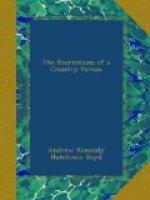the mirk darkness of a long tunnel, we emerge into
daylight again; and there, sure enough, are the bright
waters of the Clyde. We are on its south side;
it has spread out to the breadth of perhaps a couple
of miles. That rocky height on its north shore
is Dumbarton Castle; that great mass beyond is Ben
Lomond, at whose base lies Loch Lomond, the queen
of Scottish lakes, now almost as familiar to many
a cockney tourist as a hundred years since to Rob
Roy Macgregor. We keep close by the water’s
edge, skirting a range of hills on which grow the
finest strawberries in Scotland. Soon, to the
right, we see many masts, many great rafts of timber,
many funnels of steamers; and there, creeping along
out in the middle of the river, is the steamer we
are to join, which left Glasgow an hour before us.
We have not stopped since we left Glasgow; thirty-five
minutes have elapsed, and now we sweep into a remarkably
tasteless and inconvenient station. This is Greenock
at last; but, as at Glasgow, the station is some forty
feet above the ground. A railway cart at the
foot of a long stair receives the luggage of passengers,
and then sets off at a gallop down a dirty little lane.
We follow at a run; and, a hundred and fifty yards
off, we come on a long range of wharf, beside which
lie half-a-dozen steamers, sputtering out their white
steam with a roar, as though calling impatiently for
their passengers to come faster. Our train has
brought passengers for a score of places on the Frith;
and in the course of the next hour and a half, these
vessels will disperse them to their various destinations.
By way of guidance to the inexperienced, a post is
erected on the wharf, from which arms project, pointing
to the places of the different steamers. The idea
is a good one, and if carried out with the boldness
with which it was conceived, much advantage might
be derived by strangers. But a serious drawback
about these indicators is, that they are invariably
pointed in the wrong direction, which renders them
considerably less useful than they might otherwise
be. Fortunately we have a guide, for there is
not a moment to lose. We hasten on board, over
an awkward little gangway, kept by a policeman of
rueful countenance, who punches the heads of several
little boys who look on with awe. Bareheaded
and bare-footed girls offer baskets of gooseberries
and plums of no tempting appearance. Ragged urchins
bellow ’Day’s Penny Paper! Glasgow
Daily News!’ In a minute or two, the ropes are
cast off, and the steamers diverge as from a centre
to their various ports.
We are going to Dunoon. Leaving the ship-yards of Greenock echoing with multitudinous hammerings, and rounding a point covered with houses, we see before us Gourock, the nearest to Greenock of the places ‘down the water.’ It is a dirty little village on the left side of the Frith. A row of neat houses, quite distinct from the dirty village, stretches for two miles along the water’s edge. The hills rise immediately behind these. The Frith




